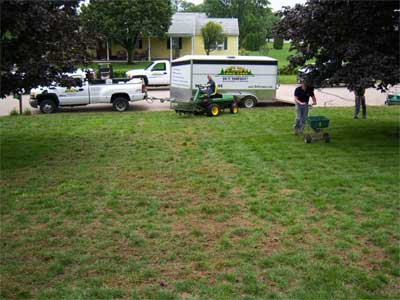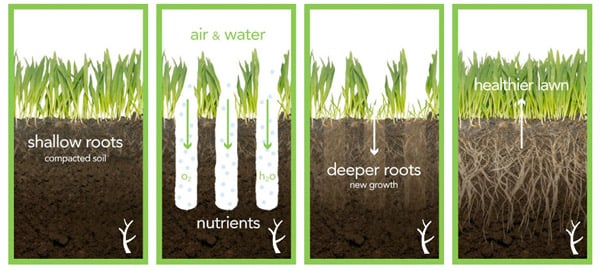To aerate and overseed your lawn, first, use a core aerator machine to create small holes in the soil, then spread seed evenly over the entire lawn and water it frequently. Aerating and overseeding helps to improve soil health and provide new grass growth for a healthier, more vibrant lawn.

Credit: www.saferlawns.com
By aerating, you allow air, water, and nutrients to reach the roots of the grass, promoting growth and reducing soil compaction. Overseeding introduces new grass seed to fill in bare spots and create a thicker, lusher turf. This process can rejuvenate an otherwise dull and patchy lawn, resulting in a greener and more attractive outdoor space.
Follow these steps to achieve a beautiful and healthy lawn.
Benefits Of Aeration And Overseeding
Aeration and overseeding are crucial lawn care practices that offer numerous benefits for maintaining a healthy and vibrant lawn. These practices help improve soil structure by breaking up compacted soil and promoting better root development. By allowing air, water, and nutrients to penetrate the soil more effectively, aeration and overseeding enhance water and nutrient absorption, ensuring that your grass receives the necessary elements for growth and vitality.
Another advantage of aeration and overseeding is reducing soil compaction. Compacted soil prevents the roots from establishing deep into the ground, leading to weaker grass and increased susceptibility to drought and disease. Thinning and bare spots on the lawn can also be addressed by overseeding. This process helps thicken existing grass and fill in bare areas, resulting in a denser and more aesthetically pleasing lawn.
Overall, aeration and overseeding contribute to the overall health of your lawn. By improving soil structure, enhancing water and nutrient absorption, reducing compaction, and promoting thicker grass growth, these practices will give you a lush and resilient lawn that can better withstand environmental stressors.
Preparing For Aeration And Overseeding
To prepare for aeration and overseeding, it is important to assess the condition of your lawn. Look for areas that have bare spots, thinning grass, or compacted soil. These are signs that your lawn may benefit from the process.
Selecting the right time is crucial for successful aeration and overseeding. The best time for aeration is during the growing season when the grass can quickly recover. Fall or early spring is usually recommended.
Obtaining the necessary tools and materials is essential. You will need an aerator machine or hand aerator, grass seed, fertilizer, and soil amendments if necessary.
Preparation of the lawn involves mowing the grass to a short height, removing any debris or thatch, and watering the lawn thoroughly a day or two before the process. This will make it easier for the aerator to penetrate the soil and for the grass seed to make contact with the soil.
How to Aerate And Overseed Lawn : Step by Step Guide
For a healthy and vibrant lawn, it is important to aerate and overseed regularly. Aeration helps to improve the soil structure by allowing air, water, and nutrients to reach the grassroots. Overseeding, on the other hand, fills in thin areas and promotes new growth.
1. Mowing and Raking the Lawn: Start by mowing the lawn at the usual height. Then, rake the lawn to remove any debris or thatch.
2. Preparing the Aerator: Check the aerator and ensure it is in good working condition. Adjust the tines or blades based on the type of aerator being used.
3. Aerating the Lawn: Begin aerating the lawn, making multiple passes to cover the entire area. Overlap each pass slightly to ensure thorough aeration.
4. Collecting the Aeration Plugs: Let the pulled plugs remain on the lawn. They will break down and return nutrients to the soil.
5. Spreading Seed and Fertilizer: Prepare the seed mixture and spread it evenly over the lawn. If needed, apply a thin layer of fertilizer as well.
6. Watering the Lawn Properly: Water the lawn immediately after overseeding. Keep the soil damp but not soaked until the new grass establishes and grows.
Aftercare And Maintenance
Monitoring Germination and Growth: After aerating and overseeding your lawn, it’s crucial to monitor the germination and growth of the new seedlings. Keep a close eye on the area and make sure the seeds are sprouting and taking root. Water the lawn regularly but avoid excessive watering, as it can lead to shallow root growth.
Mowing and Watering Post-Aeration and Overseeding: Once the new grass reaches a height of about three inches, it’s time to mow. Set your lawnmower blades at a higher level to allow the new grass to establish strong roots. Water the lawn deeply and infrequently, ensuring that the soil remains moist but not waterlogged.
Maintaining Proper Nutrient Levels: To promote healthy growth, continue fertilizing your lawn. Choose a slow-release fertilizer with high phosphorous content and apply it according to the instructions. Avoid using weed and feed products as they may harm the new seedlings.
Weed Control and Management: Control and manage weeds by hand-pulling or spot spraying with a selective herbicide. Avoid using broad-spectrum herbicides, as they can damage the newly seeded grass. Regularly inspect the lawn for weed infestations and address them promptly.
Addressing Disease and Pest Issues: Keep a lookout for any signs of diseases or pest infestations in your lawn. Monitor for brown patches, fungal growth, or insect damage. If any issues arise, consult with a professional to identify the problem and apply appropriate treatments.
Frequently Asked Questions Of How To Aerate And Overseed Lawn
Do You Overseed Before Or After Aeration?
Overseeding should be done after aeration. This allows the grass seed to penetrate the soil more easily and increases the chances of successful germination and growth. By aerating first, you create openings in the soil for the seed to settle into, ensuring optimal contact with the soil and nutrients.
Should I Aerate My Lawn Before Overseeding?
Yes, aerating your lawn before overseeding is recommended. Aeration helps loosen compacted soil, allowing water, air, and nutrients to reach the roots. This creates optimal conditions for new grass seed to grow and thrive.
How Do I Prepare My Lawn For Aeration And Overseeding?
To prepare your lawn for aeration and overseeding, follow these steps: 1. Remove any debris or weeds from the lawn. 2. Mow the grass short and rake up the clippings. 3. Water the lawn thoroughly a day before aeration. 4.
Aerate the lawn with a core aerator to improve soil compaction. 5. Spread grass seed evenly over the lawn and water regularly for optimal growth.
What Month Should I Aerate My Lawn?
Aerate your lawn in early spring or fall for best results.
Conclusion
Taking care of your lawn is essential for its health and appearance, and aerating and overseeding are key steps in achieving a lush and vibrant lawn. By aerating, you ensure that the soil gets enough oxygen, water, and nutrients, while overseeding fills in any bare or thin patches, resulting in a thicker and healthier lawn.
Follow the steps outlined in this guide to get started on aerating and overseeding your lawn, and enjoy the benefits of a beautiful and robust green space.

